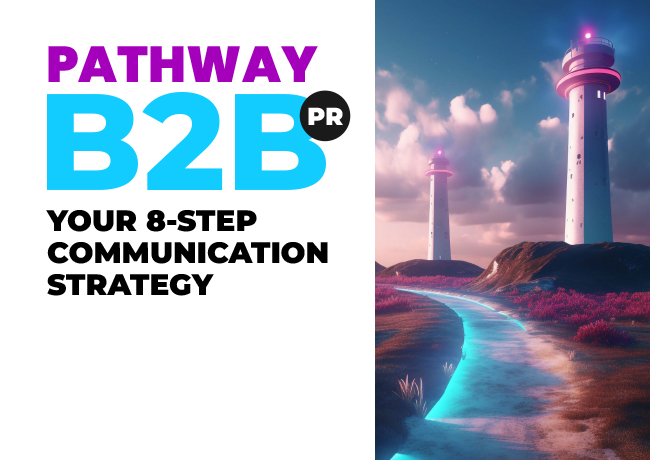
SMART PR: Measurable PR Objectives for Success
Our PR goals might be to persuade the public to adopt more ecological habits, to advance an organisations’ mission, or to boost the growth of an ideology. Whatever our mission, PR has potential to impact numbers that enamour the revenue team too: sales, leads, awareness, trust, and familiarity. This potent combination opens the door for commercial conversations.
Sounds great, right?
All the above is, of course, desirable, when measured well. To iterate and improve over time, as well as to expand on what works, is only possible when measuring PR success with SMART goals. Sadly, our team at EC-PR has been called in to pick up the pieces after promising PR and communications leaders who had what looked like a solid PR plan, but was in fact a list of tactics and campaigns.
Often absent, or ill-defined are strategic, business focused, PR objectives. If PR goals are absent, you are missing a critical opportunity to tie PR efforts to what matters most to your boss or your client: business goals and revenue, not to mention a chance to measure success across multiple areas like messaging, audience refinement, and market receptibility.
Feeling like a fish out of water just reading this? We’ve got your back. Get SMART, with these PR objectives, examples, and planning strategy.
GOST with intention: PR goals vs PR objectives
A problem we run into a lot, not only when measuring PR success and shortcomings, is a pervasive and widespread confusion between Goals, Objectives, Strategy and Tactics (GOST). Although each element of GOST fundamentally refers to “what you want to achieve”, the difference between the terms is critical. Each one plays a different role in mapping out your plan, so getting them right drives precision and clarity.
A goal is an abstract vision.
Broader than the objective, a goal is typically longer term or indefinite, and focuses on an organisation’s reputation or positioning.
For example: To be the leading global provider of high-tech security services.
Smart goals accelerate business, SMART objectives drive revenue
Objectives are measurable outcomes. They trace the steps towards realising your goal. PR objectives must be shorter-term and time sensitive to motivate and be measurable too. We will always recommend using the SMART approach (specific, measurable, attainable, realistic and timebound) because it pushes companies to consider what they hope their target audience will think, feel, and do when exposed to a given campaign.
For example: We will be perceived as the global leader by 70% of customers and prospects in 12 months time, as measured by analyst reports in the field, and the local leader by 90% of the same audience.”
Strategy is how you realise your PR objectives.
A strategy is an approach that moves you from where you are now to where you want to be. These are the guiding principles for everything you do, that gives you a roadmap on how to realise your PR objective. Wider than tactics, your strategy still needs to be SMART.
For example: To position the company as an authoritative voice on the subject of consumer privacy and our leaders as trustworthy advisors on the subject, as measured by organic invitations to speaking and collaborative events.
Tactics are a PR to-do list.
Specific and measurable, tactics focus on the efforts required to achieve your objectives and goals. Crucially, they must align with your strategy.
For example: To place our C-suite executives as speakers at 5 leading industry events we identified as influential; publish 12 op-eds on key industry issues in respected news sources; to develop an evergreen research report that can display the depth of our investigation, etc.
Measuring PR success to shore up budgets
Good PR measurement proves its value to revenue leadership. This is not rocket science but it merits repeating because few people seem to act on their knowledge of the importance of PR objectives.
Once you have those SMART PR objectives in place, with a powerful goal as the driving force, the next step is to make sure you can measure what’s working and what’s not.
How to measure PR effectiveness
The wise owls at the top of EC-PR will tell you: drop the vanity metrics first. You’re not going to like this list, but we’re here to inform, not to please:
- Impressions
- Likes
- Shares
- Comments that don’t ask high-intent questions
- Followers
- Open rates
- Views
- Traffic when not matched by sign-ups
Now you’ve got a nice clean slate, let’s measure what DOES move the needle:
- Media coverage and media reach
- Share of Voice (SoV)
- The results of sentiment analysis
We hear you ask, “if these metrics are the bees knees, why haven’t we heard of them as ways to measure PR effectiveness?” The answer is: They are hard to measure.
There are tools that can give you a rough insight, but if we haven’t made it clear already: the measurement of PR objectives must be SMART, and the first word of that is specific. If you work with estimates that are a little off, that could not only make measuring your PR success difficult, you could lose the trust of any superiors holding the purse strings.
The holy grail of PR measurement success
If you can answer this question, you’ll be able to set the SMARTest goals and objectives:
What does my ideal customer need?
When your PR answers the questions of your ideal customer profile or ICP, assuages their concerns, and connects with them on a molecular level, they will buy as soon as they are ready.
The way to achieve this is by having clear and consistent messaging at the heart of everything you do, so that absolutely any PR agency, outsourced media buyer, freelance content writer, right down to your summer interns, knows how to talk about your company in a way that gives customers what they need.
A company that is excelling at PR objective setting
To exemplify all of the above, here is the story of a company that understood what their ICP needs, then nailed their SMART objectives and, consequently, raised revenue by 16% in 3 months.
[This story has been simplified for the purposes of this post and remains anonymous.]
A Fintech with a strong visual identity, and talented founders at the helm, was solving a crucial problem: Reaching the unbanked with an easy-to-use mobile app.
To build an outstanding PR strategy, first, they identified the emotional and also very practical need they were solving: People needed to receive payments in order to enter the gig economy online.
To spread the word on how they solve this need, some of their SMART goals were to:
- Be featured once a month in 4 hyper local print newspapers they had identified as being read by people under 30.
- Position their founder on regional radio stations to offer financial advice, not sell their product, to entrepreneurs.
- Reiterate their mission to boost entry to the gig economy and empower young workers in every piece of PR.
As a result, they were able to set a roadmap to building close relationships with local news outlets, radio stations, and presenters, in order to begin securing spots.
Admittedly, in the first 3 months, they did not achieve their monthly goals, but their efforts gained momentum such that after 6 months, they had met every important PR objective they had set, plus those of the previous quarter.
This story shows the power of smart PR, backed by SMART goals.
If you’re intrigued to learn more about PR for technology companies, and especially start tracing your roadmap to success, see our 8-step communication strategy guide.

Your 8-Step Communication Strategy Guide
A comprehensive guide to delivering your business goals using intelligent and relevant messaging.
Subscribe to our updates
Stay up to date with the latest insights, case studies, and PR guides.



